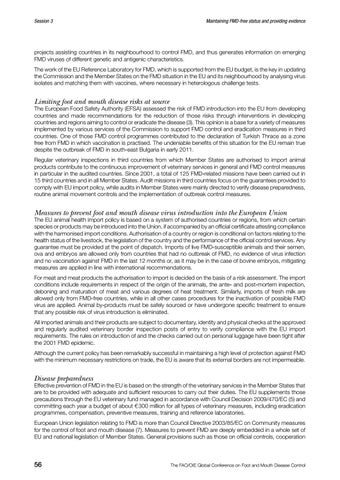Session 3
Maintaining FMD-free status and providing evidence
projects assisting countries in its neighbourhood to control FMD, and thus generates information on emerging FMD viruses of different genetic and antigenic characteristics. The work of the EU Reference Laboratory for FMD, which is supported from the EU budget, is the key in updating the Commission and the Member States on the FMD situation in the EU and its neighbourhood by analysing virus isolates and matching them with vaccines, where necessary in heterologous challenge tests.
Limiting foot and mouth disease risks at source The European Food Safety Authority (EFSA) assessed the risk of FMD introduction into the EU from developing countries and made recommendations for the reduction of those risks through interventions in developing countries and regions aiming to control or eradicate the disease (3). This opinion is a base for a variety of measures implemented by various services of the Commission to support FMD control and eradication measures in third countries. One of those FMD control programmes contributed to the declaration of Turkish Thrace as a zone free from FMD in which vaccination is practised. The undeniable benefits of this situation for the EU remain true despite the outbreak of FMD in south-east Bulgaria in early 2011. Regular veterinary inspections in third countries from which Member States are authorised to import animal products contribute to the continuous improvement of veterinary services in general and FMD control measures in particular in the audited countries. Since 2001, a total of 125 FMD-related missions have been carried out in 15 third countries and in all Member States. Audit missions in third countries focus on the guarantees provided to comply with EU import policy, while audits in Member States were mainly directed to verify disease preparedness, routine animal movement controls and the implementation of outbreak control measures.
Measures to prevent foot and mouth disease virus introduction into the European Union The EU animal health import policy is based on a system of authorised countries or regions, from which certain species or products may be introduced into the Union, if accompanied by an official certificate attesting compliance with the harmonised import conditions. Authorisation of a country or region is conditional on factors relating to the health status of the livestock, the legislation of the country and the performance of the official control services. Any guarantee must be provided at the point of dispatch. Imports of live FMD-susceptible animals and their semen, ova and embryos are allowed only from countries that had no outbreak of FMD, no evidence of virus infection and no vaccination against FMD in the last 12 months or, as it may be in the case of bovine embryos, mitigating measures are applied in line with international recommendations. For meat and meat products the authorisation to import is decided on the basis of a risk assessment. The import conditions include requirements in respect of the origin of the animals, the ante- and post-mortem inspection, deboning and maturation of meat and various degrees of heat treatment. Similarly, imports of fresh milk are allowed only from FMD-free countries, while in all other cases procedures for the inactivation of possible FMD virus are applied. Animal by-products must be safely sourced or have undergone specific treatment to ensure that any possible risk of virus introduction is eliminated. All imported animals and their products are subject to documentary, identity and physical checks at the approved and regularly audited veterinary border inspection posts of entry to verify compliance with the EU import requirements. The rules on introduction of and the checks carried out on personal luggage have been tight after the 2001 FMD epidemic. Although the current policy has been remarkably successful in maintaining a high level of protection against FMD with the minimum necessary restrictions on trade, the EU is aware that its external borders are not impermeable.
Disease preparedness Effective prevention of FMD in the EU is based on the strength of the veterinary services in the Member States that are to be provided with adequate and sufficient resources to carry out their duties. The EU supplements those precautions through the EU veterinary fund managed in accordance with Council Decision 2009/470/EC (5) and committing each year a budget of about € 300 million for all types of veterinary measures, including eradication programmes, compensation, preventive measures, training and reference laboratories. European Union legislation relating to FMD is more than Council Directive 2003/85/EC on Community measures for the control of foot and mouth disease (7). Measures to prevent FMD are deeply embedded in a whole set of EU and national legislation of Member States. General provisions such as those on official controls, cooperation
56
The FAO/OIE Global Conference on Foot and Mouth Disease Control
















